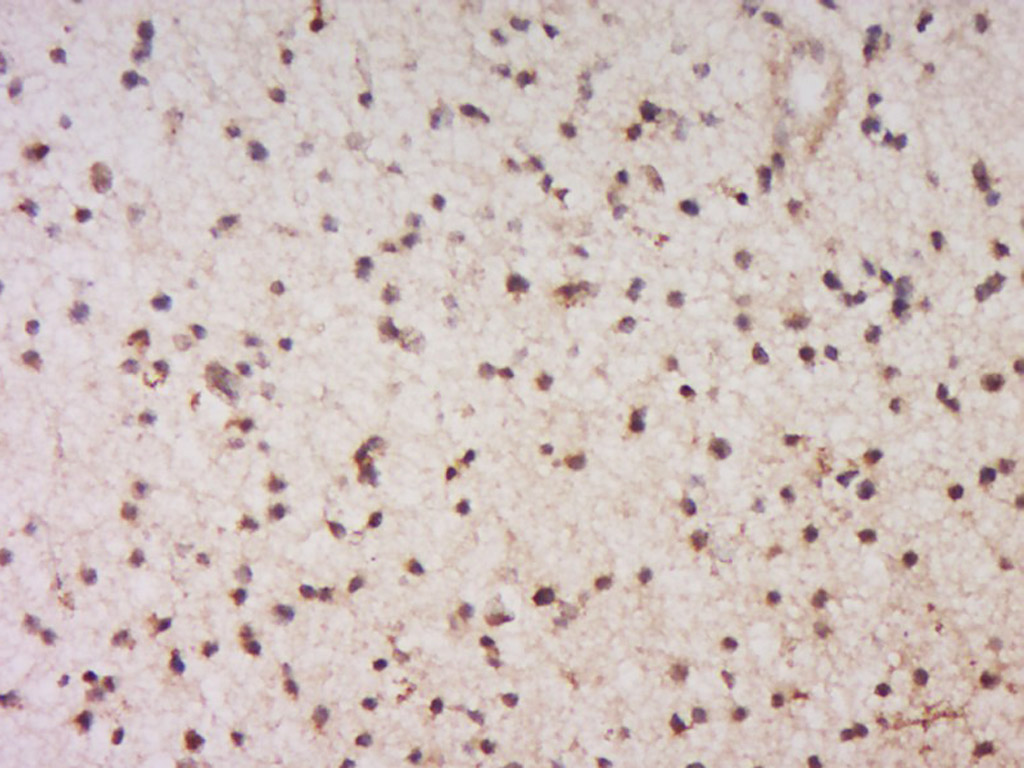
Rabbit Anti-EYA1 antibody
BOP; BOR; Eya1; EYA1_HUMAN; eyes absent 1; eyes absent 1 homolog; eyes absent homolog 1 (Drosophila); Eyes absent homolog 1; eyes absent homolog1; MGC141875
View History [Clear]
Details
Product Name EYA1 Chinese Name 转录因子EYA1抗体 Alias BOP; BOR; Eya1; EYA1_HUMAN; eyes absent 1; eyes absent 1 homolog; eyes absent homolog 1 (Drosophila); Eyes absent homolog 1; eyes absent homolog1; MGC141875 Research Area Developmental biology Epigenetics Immunogen Species Rabbit Clonality Polyclonal React Species Human, Applications ELISA=1:5000-10000 IHC-P=1:100-500 IHC-F=1:100-500 ICC=1:100-500 IF=1:100-500 (Paraffin sections need antigen repair)
not yet tested in other applications.
optimal dilutions/concentrations should be determined by the end user.Theoretical molecular weight 65kDa Cellular localization The nucleus cytoplasmic Form Liquid Concentration 1mg/ml immunogen KLH conjugated synthetic peptide derived from human EYA1: 231-330/592 Lsotype IgG Purification affinity purified by Protein A Buffer Solution Preservative: 15mM Sodium Azide, Constituents: 1% BSA, 0.01M PBS, pH 7.4 Storage Shipped at 4℃. Store at -20 °C for one year. Avoid repeated freeze/thaw cycles. Attention This product as supplied is intended for research use only, not for use in human, therapeutic or diagnostic applications. PubMed PubMed Product Detail A gene on chromosome 8q13.3 encodes EYA1 (eyes absent), a protein with 16 exons. EYA1 is one of four members of the eyes absent family. A 271 amino acid domain at the carboxyl terminal is highly conserved amongst the members of the eyes absent family, while the PST (proline-serine-threonin)-rich amino terminal is highly divergent. EYA is expressed in flexor tendons and the developing central nervous system, kidney, eye and ear. EYA1 acts a transcriptional activator in connective tissue patterning through its PST domain, which functions as a transactivation domain. EYA1 plays a critical role in the development of the inner ear and kidney. EYA is involved in early inductive signaling, acting upstream of GDNF. EYA1 has been implicated in the autosomal dominant disorders branchio-oto-renal (BOR) syndrome and branhio-oto (BO) syndrome.
Function:
Tyrosine phosphatase that specifically dephosphorylates 'Tyr-142' of histone H2AX (H2AXY142ph). 'Tyr-142' phosphorylation of histone H2AX plays a central role in DNA repair and acts as a mark that distinguishes between apoptotic and repair responses to genotoxic stress. Promotes efficient DNA repair by dephosphorylating H2AX, promoting the recruitment of DNA repair complexes containing MDC1. Its function as histone phosphatase probably explains its role in transcription regulation during organogenesis. Seems to coactivate SIX2, SIX4 and SIX5. May be required for normal development of branchial arches, ear and kidney.
Subunit:
Probably interacts with SIX2, SIX4 and SIX5.
Subcellular Location:
Cytoplasm. Nucleus. Localizes at sites of DNA damage at double-strand breaks.
Tissue Specificity:
In the embryo, highly expressed in kidney with lower levels in brain. Weakly expressed in lung. In the adult, highly expressed in heart and skeletal muscle. Weakly expressed in brain and liver. No expression in eye or kidney.
Post-translational modifications:
Sumoylated by SUMO1.
DISEASE:
Defects in EYA1 are the cause of branchiootorenal syndrome type 1 (BOR1) [MIM:113650]; also known as Melnick-Fraser syndrome. BOR is an autosomal dominant disorder manifested by various combinations of preauricular pits, branchial fistulae or cysts, lacrimal duct stenosis, hearing loss, structural defects of the outer, middle, or inner ear, and renal dysplasia. Associated defects include asthenic habitus, long narrow facies, constricted palate, deep overbite, and myopia. Hearing loss may be due to mondini type cochlear defect and stapes fixation. Penetrance of BOR syndrome is high, although expressivity can be extremely variable.
Defects in EYA1 are the cause of otofaciocervical syndrome (OFCS) [MIM:166780]. The syndrome is characterized by trophic alterations of the facies and shoulder girdle in addition to the malformations seen in BOR.
Defects in EYA1 are the cause of branchiootic syndrome type 1 (BOS1) [MIM:602588]; also known as BO syndrome type 1 or branchiootic dysplasia. Individuals with BOS1 are affected by the same branchial and otic anomalies as those seen in individuals with BOR1, but lack renal anomalies.
Similarity:
Belongs to the HAD-like hydrolase superfamily. EYA family.
SWISS:
Q99502
Gene ID:
2138
Database links:Entrez Gene: 395718 Chicken
Entrez Gene: 2138 Human
Entrez Gene: 14048 Mouse
Omim: 601653 Human
SwissProt: Q9YHA0 Chicken
SwissProt: Q99502 Human
SwissProt: P97767 Mouse
Unigene: 491997 Human
Unigene: 250185 Mouse
Product Picture
Antigen retrieval: citrate buffer ( 0.01M, pH 6.0 ), Boiling bathing for 15min; Block endogenous peroxidase by 3% Hydrogen peroxide for 30min; Blocking buffer (normal goat serum,C-0005) at 37℃ for 20 min;
Incubation: Anti-EYA1 Polyclonal Antibody, Unconjugated(SL20158R) 1:500, overnight at 4°C, followed by conjugation to the secondary antibody(SP-0023) and DAB(C-0010) staining
Bought notes(bought amounts latest0)
No one bought this product
User Comment(Total0User Comment Num)
- No comment



 +86 571 56623320
+86 571 56623320
 +86 18668110335
+86 18668110335

